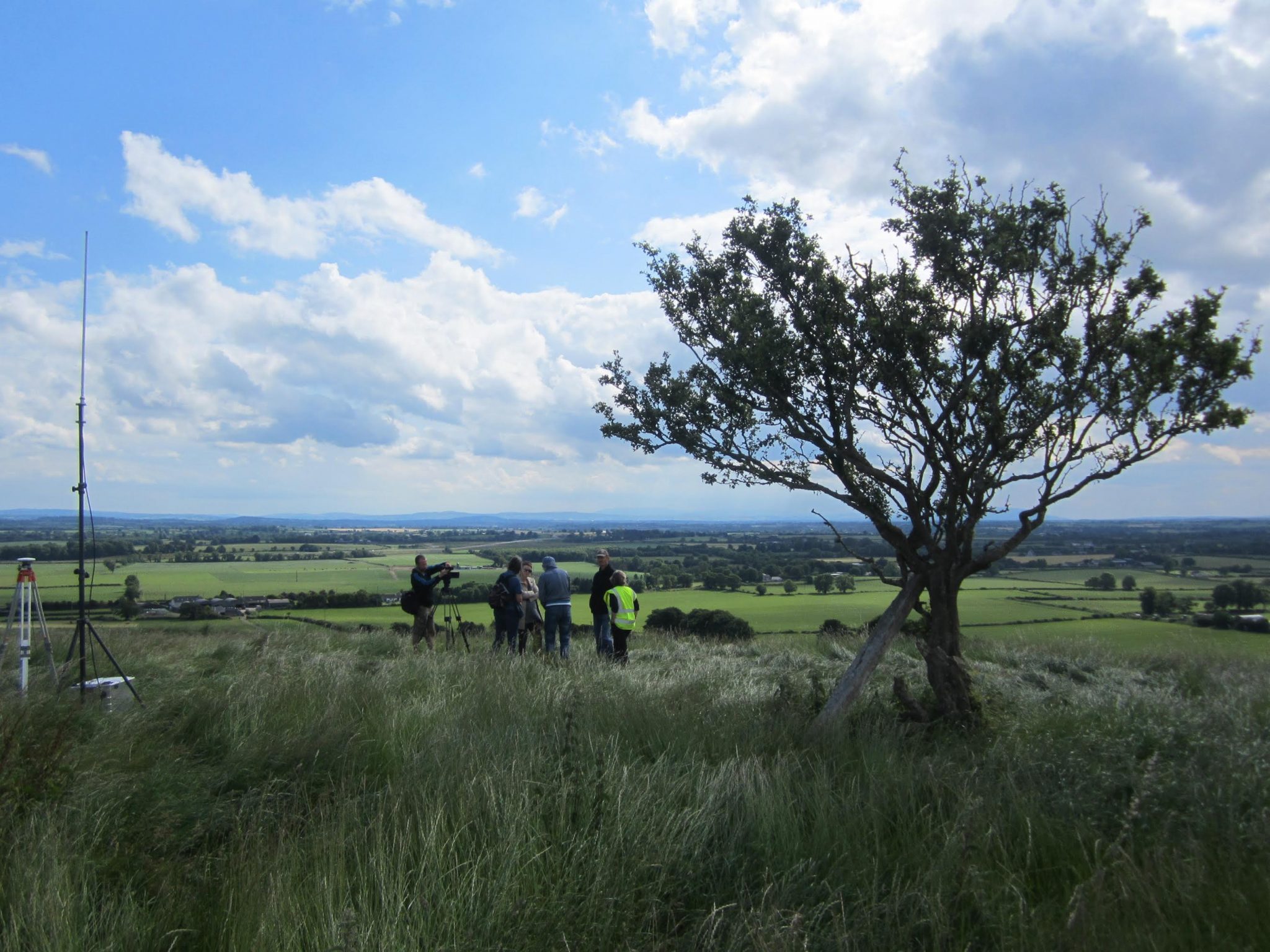In 2012, Ancient History Encyclopedia (AHE) profiled the work of the Late Iron Age and Roman Ireland Project. The central aim of this project was to characterize the environment, settlement patterns, social structures, and ritual practices of the people who lived and died in Ireland during the first five centuries CE. It also surveyed the nature of Ireland’s interactions with the Roman Empire — especially with Roman Britain — in order to reconstruct a more holistic archaeological narrative for the later Irish Iron Age. In this exclusive interview, James Blake Wiener of Ancient History Encyclopedia (AHE) speaks again to Dr. Jacqueline Cahill Wilson about the findings of this unprecedented archaeological project.
JW: Dr. Jacqueline Cahill Wilson, welcome back to Ancient History Encyclopedia (AHE). It is delightful to be speaking to you once more about the Late Iron Age and Roman Ireland (LIARI Project of the Discovery Programme), which concerned Late Iron Age Ireland’s relationship with the Roman Empire. Yours was a project that excited many AHE’s users and readers back in 2012.
What were your highlights and what was the most intriguing discovery that you and your team made in your estimation?
JCW: Thank you James, I am delighted to give readers at Ancient History Encyclopedia an update, but I should probably say at the outset that, as I no longer work for the Discovery Programme, these are entirely my own musings as a retrospective of the LIARI project. I think the last time we spoke in 2012 we were planning a conference “Ireland in a Roman World” at Trinity College Dublin, and we were delighted by its success. We had nearly 200 delegates attend from all over Europe and an international line up of speakers who were asked for the first time to consider parallels with Ireland within the research papers they were presenting.
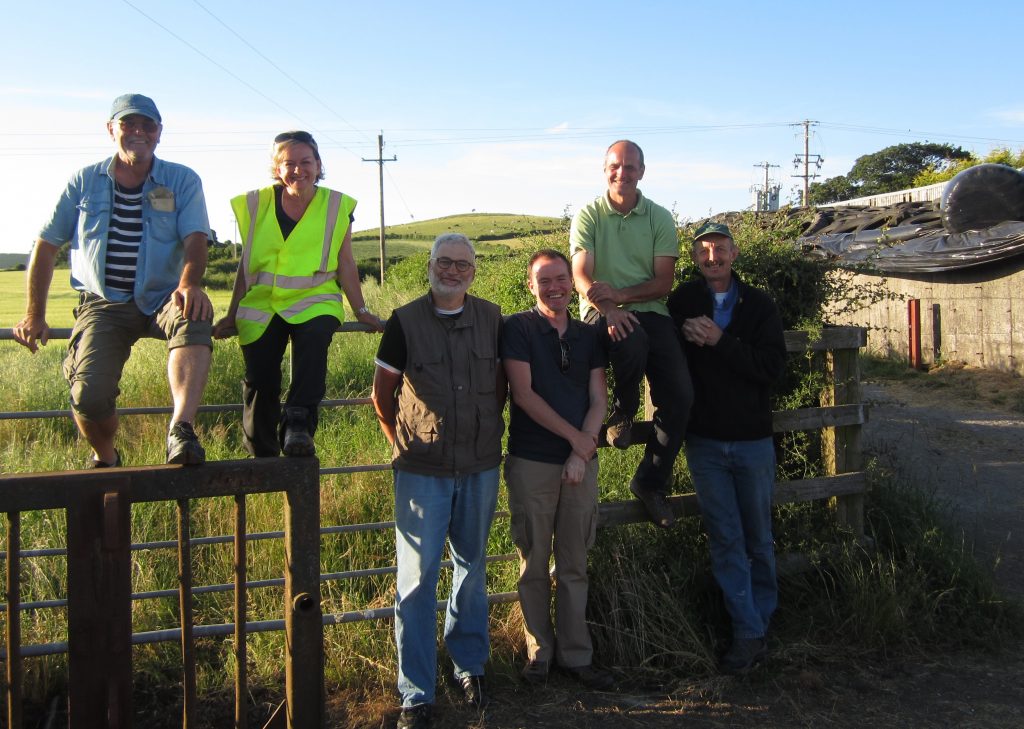
Dr. Jacqueline Cahill Wilson (second from left) and her team researched the ties, which bound Late Iron Age Ireland with the wider Roman world. (Photo: Courtesy of Dr. Jacqueline Cahill Wilson and the Late Iron Age and Roman Ireland Project.)
Some of the contacts we made at that time have since become great friends and colleagues, and I have had the pleasure of presenting our research on Ireland alongside them at Roman conferences in the UK and in Europe. We were lucky enough to get a second phase of research funding which ran from 2013 to 2015 and that allowed us to complete as much as we could before resources and research funding came to an end in March 2015. We published a book on the first phase (2011-2013) in December 2014, aptly entitled Late Iron Age and Roman Ireland, and we were delighted that one of the most distinguished archaeologists in Ireland — and one of the founding fathers of Discovery Programme, Professor George Eogan, launched the publication with much praise for the innovative nature of the research, and of course the Late Iron Age and Roman Ireland project team members.
“Now that people are aware that Roman finds are relevant and important to Irish history, we are getting reports of more turning up and old finds are brought to our attention.” ~Dr. Jacqueline Cahill Wilson
For me in terms of highlights, I think I am torn between the week we spent conducting surveys on Lambay Island with rolling sea mists, puffins, and Irish wallabies, or the week on top of the iconic Freestone Hill in Kilkenny. In both cases, I found myself in the very best of company, blessed with good weather and some pretty amazing survey results — so am I allowed two highlights? As far as intriguing finds go, it is hard to choose any one in particular, but when we working through all of the Roman finds from Newgrange in the collection held at the museum in Dublin alongside the Roman gold coins and plate brooches, which are exquisite, was a small leaf-shaped piece of bronze, which had an ogham inscription scratched into the front. Ogham as your readers may know, is the earliest form of writing known in Ireland, consisting of an alphabet of linear strokes made either side or across a vertical line. Recent research has shown that in its earliest form it dates from the fourth century CE.
What was intriguing in this case is whether this actually came from the same contexts as the Roman material, as its form, shape, and size is similar to some of the much more elaborate votive leaves that have been found at Roman shrines in Britain. Its catalogue description did not actually make its context clear, and it could of course be much later. But we do know that a small ogham inscription was found in a securely dated content during the excavation of Raffin hill fort also in Count Meath, dating to around the fourth century CE. The Roman finds from Newgrange date from the Flavian period (69-96 CE) through to the fifth century CE, and these were single deliberate deposits of exceptional quality jewellery and coins over the entire Roman period. I think there is a very nice piece of research still left unfinished with this, so I am planning another paper to explain its story.

Newgrange is a Neolithic monument located in the region of Bru na Boinne, County Meath, Ireland. There are thirty-seven tombs located in the valley of Bru na Boinne (Mansion of the Boyne) and it is considered to be one of the most famous and significant megalithic complexes in Europe. Newgrange was constructed c. 3200 BCE. (Original image by Bruno Panel. Uploaded by Dominique Chapman, published on 03 September 2015 under the following license: Creative Commons: Attribution-NonCommercial-ShareAlike.)
JW: What unexpected challenges did you face during the excavation part of the project? How were these challenges met and addressed?
JCW: Now that is a good question, as we all know that by the very nature of projects such as this there were bound to be hiccups along the way. For me, it was an absolute privilege to work with some of the best archaeologists and scholars in Ireland — most were so generous with their time and support and I learned a great deal from all of them. I have to name-check a few though as we had amazing support from staff and scholars across the disciplines at Trinity College Dublin and University College Dublin and colleagues in many public organizations like the National Museum of Ireland guided us through the licensing process and helped us to locate old finds and burials, (special thanks to the Assistant Keeper Dr. Andy Halpin) and staff at the TII (formerly National Roads Authority) made all of their unpublished and published data available to us. It is mainly due to the collaborative nature of the work and because of all of the help we received that the research project was a resounding success.
As far as overcoming challenges are concerned, it is over a year since the project finished and a quote from Elvis immediately comes to mind “Wise men say, only fools rush in” and with the benefit of hindsight, I think I was woefully naïve about the reception of the project in some quarters. I really did think that everyone would jump at the opportunity to come on board to shine a light on what must be the most exciting new period of research in Ireland, and we certainly had the potential and the resources to investigate the most important Roman site in Ireland, which is located at Drumanagh in County Dublin. But I was not at all prepared for the political complexities of actually delivering any research on that site, and I was actually quite shocked by some of the hostility that was leveled at me personally for trying so hard to achieve this. That we managed to publish as much as we did was a huge achievement for all the team involved and a credit to the tenacity of our dedicated colleagues. Although the project for the Discovery Programme was brought to a close in March 2015, I am delighted to say that the “gauntlet” has been picked up and the research has continued apace.
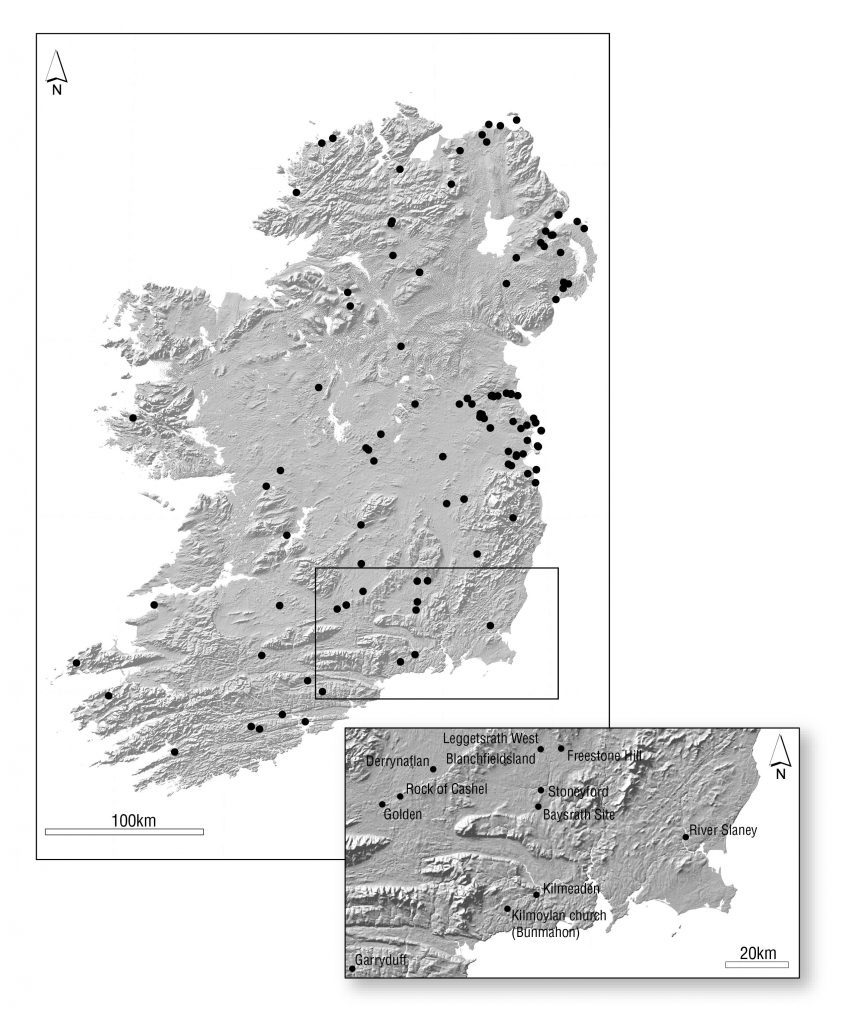
Sites surveyed across Ireland by LIARI. (Photo: Courtesy of Dr. Jacqueline Cahill Wilson and the Late Iron Age and Roman Ireland Project.)
JW: It appears that the Romans exerted a strong influence on Kilkenny, in particular, but why was that the case? Where else did the Romans leave a strong imprint on the island?
JCW: They did, but not just in Kilkenny James, the southeast counties of Ireland in general have the most extraordinary amount of Roman evidence, which dates from the around the mid-first century CE, so not long after the Roman conquest of Britain, right through to the end of Roman control in the Western Empire. Now that people are aware that Roman finds are relevant and important to Irish history, we are getting reports of more turning up and old finds are brought to our attention. And this is where the research has been given a new focus (and team) as it is continuing with the help of the brilliantly talented archaeologist Cóilín Ó Drisceoil and we have been carrying out research under the aegis of Kilkenny Archaeology with much help and support from friends and colleagues at UCD, as well as University of Bristol and University of Leicester in the UK.
In fact, we were back on site at Freestone Hill, earlier in the summer with colleagues from the Romano-Germanic Commission (Römisch-Germanische Kommission) of the German Archaeological Institute, who did the prior geophysical survey for us in the last days of the project. The results are extraordinary with the surveys revealing an array of likely exciting archaeology including one or two very enigmatic features, the closest parallels for which comes from some of the small Romano-British shrines in the southwest of Britain. Not surprising though, given the nature of the Romano-British shrine on the top of Freestone Hill and the Roman pottery and jewellery excavated by Gerhard Bersu in the 1940s. (He ironically later became the Director of the RGK.) So history came full circle for us and our German colleagues. This year, we finished the last of the area under survey and we will be writing up to publish in the RGK’s journal, Berichte. Cóilín has just submitted for some research funding to see if we can finally excavate these tantalizing features, so we should know in the new year if we can do this next summer.
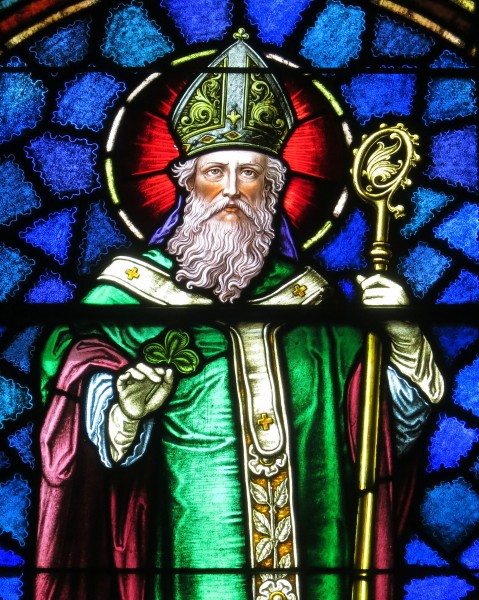
The famous St. Patrick was Romano-British by birth. (A stained glass window depicting Saint Patrick, Ireland’s patron saint. From the Saint Patrick Catholic Church, Junction City, Ohio, USA. Based on Wikipedia content that has been reviewed, edited, and republished. Original image by Nheyob. Uploaded by Mark Cartwright, published on 06 September 2015 under the following license: Creative Commons: Attribution-ShareAlike.)
It is really important to find the funding to do this as one of the key gaps in our knowledge, highlighted especially by the LIARI research into this period, is a relative dearth of clear dating sequences at these important historic sites around Ireland. Many of the very well-known historic centers such as Tara, have had little in the way of contemporary scientific analysis conducted in recent times, although swathes of geophysical surveys have been completed. But without confirming sequences through contemporary scientific excavations, geophysics like any other form of remote sensing only identifies likely archaeology, it does not in itself prove anything and interpretations that are offered continue to rely greatly on historical interpretation based on onamastic traditions and the early Irish Annals, none of which is contemporary with activity in the late Iron Age and Roman period. If we do get to excavate at Freestone Hill, we will finally get some AMS dates, but also a whole suite of palaeo-environmental sampling that will allow us to get a much clearer picture of what was happening and how people were living, not just at the site in the Late Iron Age and Roman period but following this during the late Roman to early medieval period (c. 300-600 CE).
JW: The Late Iron Age and Roman Ireland project utilized the latest scientific tools of analysis and advanced scientific methods, including geochemistry and isotope analysis. To what extent did these tools reveal the nature of Roman interaction with the ancient Irish? Could you share an example or two, Dr. Cahill Wilson?
JCW: Actually, I think this was one of the most successful aspects of the project James, and one that has continued at other sites around Ireland, with wonderful collaboration coordinated under the Irish Isotopes Research Group (IIRG). I founded the IIRG as part of the project after conversations with friends and colleagues who work in archaeological sciences, so we could share research ideas and laboratory space for all of us working on Irish material in Ireland, the UK, and Europe. As this was a comparatively new approach to analysis on older skeletal material from sites around Ireland, it was important to build up a database for comparative analysis especially as it is expensive to conduct in isolation, and it works best when you have lots of data against which you can analyze your own.
“The legacy of the project is that Ireland is now accepted as having a history that includes being part of the Roman world, in the same way that other communities around the entire Empire were engaged with the Roman military, economy, and administration in zones of interconnectivity.” ~Dr. Jacqueline Cahill Wison
We handed over the running of the group to its members before the project ended, and it now has around 70 plus members from Ireland, the UK and all over Europe. As you know, I had conducted a small sample of strontium and oxygen isotope analyses for my own doctoral research, but I had the pleasure of taking this work forward with LIARI on a wider sample of unusual burials thought to be migrants, with the help of Dr. Elizabeth O’Brien. (She is the leading burial archaeologist in Ireland, the Principal Investigator for Mapping Death, and who we were fortunate to have as the Chair of the LIARI Project Committee.) My friend Dr. Christopher Standish who is an isotope specialist (I refer to him as an “isotope Guru” for very good reason) re-validated all of my earlier results, and he redesigned and redeveloped the methodology we were using to ensure it was as robust as possible by analyzing baseline biosphere samples from the sites at which our burials were found. Dr. Ger Dowling (Assistant Project Director) and I spent a brilliant day driving around, locating sites and taking samples for Chris, and this was pretty much the last piece of research we completed for the project.
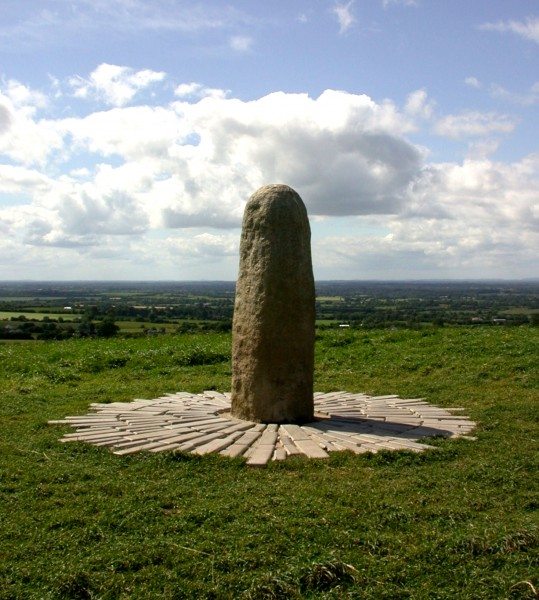
The Neolithic Lia Fail (Stone of Destiny), Hill of Tara, County Meath, Ireland, by which the ancient kings were inaugurated. (Based on Wikipedia content that has been reviewed, edited, and republished. Original image by Germán Póo-Caamaño. Uploaded by Mark Cartwright, published on 04 July 2016 under the following license: Creative Commons: Attribution.)
The results really do speak for themselves, the new dating shows that some of these are in the Late Iron Age or Roman period, and the isotope analysis suggests they spent their early childhood in Roman Britain – and indeed one individual appears to have spent his early years in northern Africa before being buried at Bettystown in County Meath. I am not sure how much more convincing the evidence needs to be to demonstrate that there were indeed people who lived and died in Ireland who were Romano-British. Chris and I recently published a much longer paper in the Journal of Archaeological Science Reports that included all of the data on isotope analyses carried out in the recent past in Ireland, which is available to download here: http://www.sciencedirect.com/science/article/pii/S2352409X16300517
JW: Now that the investigation has concluded, what do you believe will be the LIARI Project’s legacy? Could you share a final thought on your time and association with project, as well as any future research plans you may have?
JCW: Well I quoted Elvis earlier, so I might well balance that with one from Jack Nicholson: “You can’t make an omelette without breaking some eggs.” The legacy of the project is that Ireland is now accepted as having a history that includes being part of the Roman world, in the same way that other communities around the entire Empire were engaged with the Roman military, economy, and administration in zones of interconnectivity. Within these zones, people, things, and ideas moved between the formal Empire and its neighboring communities. Now that the ground has been broken, I am hopeful that up and coming scholars will join me in taking the research forward.
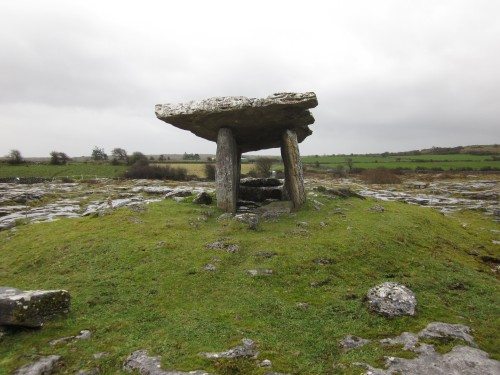
Ireland is an archaeologist’s dream and much of the island remains unexcavated. This is Poulnabrone, which is an dolmen in The Burren, County Clare, Ireland. It dates to 4200 BCE. (Photo: Courtesy of Josh J. Mark for Ancient History Encyclopedia.)
I mentioned Cóilín earlier and one other rising star is Alexandra Guglielmi who is presently finishing her doctorate at UCD under Professors Gabriel Cooney and Aidan O’Sullivan (two incredibly knowledgeable and helpful collaborators on the project so she is in very good hands), and I hope that in future the students she is presently teaching will in turn encourage their students to follow up and develop (or even challenge) our research findings. For the moment, there is so much more to do, and excavation really is the next step. I have been busy publishing quite a few papers this year already, and there are two more in the “preparation stage” and one important paper that is now in press. It will be published as the results of the second phase of the project (2013-2015) in the first thematic volume from TRAC in the spring. It can be found here: http://www.oxbowbooks.com/oxbow/romans-and-barbarians-beyond-the-frontiers.html
As for myself, I am determined to find the research funding we need to investigate these sites properly, especially as all of the research has highlighted these as so important to our understanding of this exciting and dynamic period in early Irish history. I would be even happier if we found even a single piece of Roman pottery in our trenches at Freestone Hill, so let’s just hope we get that funding!
JW: Thanks so much and congratulations! Comhghairdeas.
JCW: You are most welcome James and thank you to you and the staff of Ancient History Encyclopedia for being such advocates of the project and as we move into a new phase of research, we will keep you up to date on all things “Roman” in Ireland. If any of your readers would like to get in touch they can contact me directly at my University of Bristol email address [email protected]
Cover Image: Excavating in the Irish countryside. (Courtesy of Dr. Jacqueline Cahill Wilson and the Late Iron Age and Roman Ireland Project.)
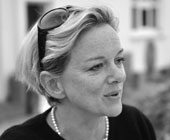 Dr. Jacqueline Cahill Wilson spent 11 years working in higher education funding and management in England before returning to academia in 2001. She received First Class Honours for a BA in Archaeology from the University of Bristol in 2004, and was awarded full funding from the Arts and Humanities Research Council (AHRC) to complete an MA in Archaeology at the University of Reading. Returning thereafter to the University of Bristol, Jacqueline completed her doctoral research again with full funding from the AHRC in 2010. Having lectured widely at all academic levels for the University of Bristol as well as for local historical and archaeological societies in Great Britain and Ireland, Jacqueline was appointed by the Discovery Programme as the Principal Investigator for the LIARI Project in September 2011. Jacqueline’s academic interests include a diverse range of topics from the Iron Age in Western Europe to the archaeology of Rome and its western provinces.
Dr. Jacqueline Cahill Wilson spent 11 years working in higher education funding and management in England before returning to academia in 2001. She received First Class Honours for a BA in Archaeology from the University of Bristol in 2004, and was awarded full funding from the Arts and Humanities Research Council (AHRC) to complete an MA in Archaeology at the University of Reading. Returning thereafter to the University of Bristol, Jacqueline completed her doctoral research again with full funding from the AHRC in 2010. Having lectured widely at all academic levels for the University of Bristol as well as for local historical and archaeological societies in Great Britain and Ireland, Jacqueline was appointed by the Discovery Programme as the Principal Investigator for the LIARI Project in September 2011. Jacqueline’s academic interests include a diverse range of topics from the Iron Age in Western Europe to the archaeology of Rome and its western provinces.
All images featured in this interview have been attributed to their respective owners. Images lent to AHE by Dr. Jacqueline Cahill Wilson and the Late Iron Age and Roman Ireland Project have been done so as a courtesy, and we thank them warmly for their generosity. Interview edited by James Blake Wiener for AHE. Unauthorized reproduction is strictly prohibited. All rights reserved. © AHE 2016. Please contact us for rights to republication.
